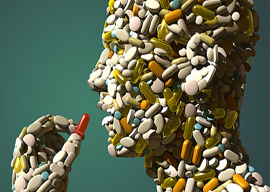
November 19, 2011

A report released Wednesday says that in 2010, one in five Americans took medication to relieve conditions broadly described as mental disorders. Such medications include antidepressants, anti-anxiety pills, pills for attention deficit hyperactivity disorder (ADHD), and good ol’ American antipsychotics.
If you sprinkle the billions of painkillers on top of the mix—it’s said that there were enough painkillers prescribed last year to keep every adult American feelin’ no pain for a solid month—you have a public landfill’s worth of legally prescribed mind-altering substances.
That’s a lot of pills, possibly a lot of crazy Americans, and maybe even too much of both.
In the USA over the past dozen years:
• Sales of prescription painkillers roughly tripled.
• The number of deaths from prescription painkillers more than tripled, killing more people than heroin and cocaine combined and accounting for three-quarters of all drug overdoses. The number of annual deaths from prescription painkillers is nearly as high as the number of homicides.
• Prescriptions (read: “legal meth”) for ADHD conditions nearly tripled among women aged 20 to 44.
• Prescriptions for atypical antipsychotics have more than tripled among adults aged 20 to 54.
• The number of Americans classified as disabled due to mental illness has more than doubled.
• Prescriptions for antidepressants rose so much, it’s depressing. In 2005, antidepressants became the most-prescribed drug in the USA.
Over the past generation, huge swaths of the public have been softly lulled into becoming compliant, dependent, mush-brained pill zombies. This phenomenon, where people on psych meds started popping up everywhere like mushrooms in a barren field, was enabled by several landmark events:
• The expansion of the Diagnostic and Statistical Manual of Mental Disorders in the 1970s that opened the legal and financial floodgates for a similar expansion of the pharmaceutical industry.
• The American Psychiatric Association’s invention of the concept of ADHD in 1987.
• The FDA’s 1997 decision to allow TV ads for prescription drugs.
• Increased payments funneled from pharmaceutical companies to psychiatrists.
• An ever-growing clinical definition of what constitutes “mental illness” to the point where what was once deemed mere shyness is recategorized as “social anxiety disorder.”
• A population that has become increasingly anxious, bored, depressed, and aimless.
These days, it seems as if everyone and their mother is on Celexa, Zyprexa, Lexapro, Paxil, Cymbalta, Sinequan, Abilify, Desyrel, and Lunesta—pills which could also be the names of new cars or black women. As if it were the Holy Eucharist, communicants are dutifully gobbling their SSRIs, SSREs, SNRIs, SARIs, NDRAs, NRIs, NDRIs, TCAs, TeCAs, and MAOIs.